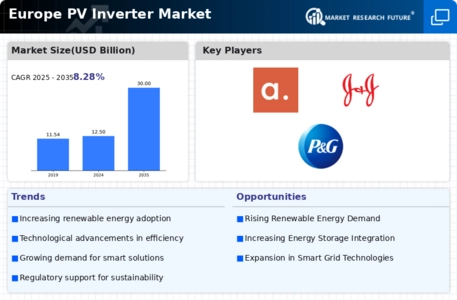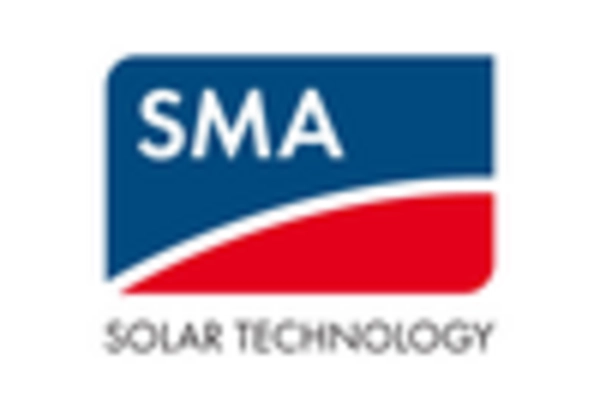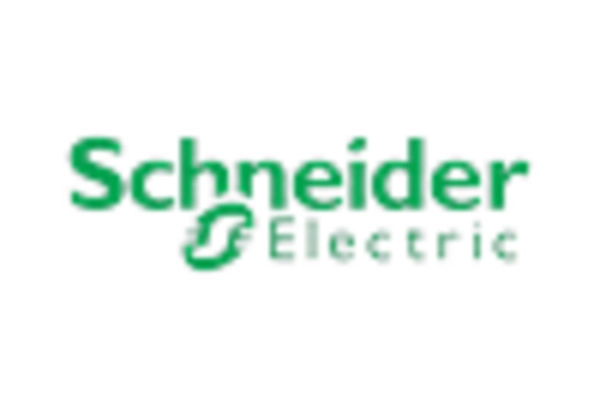Market Share
Introduction: Navigating the Competitive Landscape of the European PV Inverter Market
Inverters are undergoing a revolution in Europe, the result of rapid technology adoption, tightening regulations and increasing consumer expectations of sustainable energy solutions. Competition is fierce, and the leading inverter manufacturers, IT service companies and service providers are all trying to gain an edge by using new and advanced technologies such as machine learning, IoT integration and automation to increase efficiency and reliability. Inverter manufacturers are concentrating on product innovation and performance, while IT service companies are concentrating on integration and data management. And new entrants, especially artificial intelligence (AI)-based start-ups, are challenging the established business models and creating new value propositions. The market is expected to grow at a CAGR of 14.4 per cent over the forecast period of 2024–25.
Competitive Positioning
Full-Suite Integrators
These vendors provide comprehensive solutions encompassing both hardware and software for PV inverter systems.
| Vendor | Competitive Edge | Solution Focus | Regional Focus |
|---|---|---|---|
| Solar Edge Technologies | Advanced optimization technology | Smart inverter solutions | Europe, North America |
| Siemens Energy | Strong industrial automation expertise | Integrated energy solutions | Global, with a focus on Europe |
| SMA Solar Technology AG | Robust product portfolio | PV inverter systems | Europe, Asia, Americas |
| Delta Electronics, Inc. | Energy efficiency leadership | Inverter and energy management | Global, strong in Europe |
Specialized Technology Vendors
These vendors focus on niche technologies and innovations within the PV inverter market.
| Vendor | Competitive Edge | Solution Focus | Regional Focus |
|---|---|---|---|
| Fimer Group | Innovative inverter technology | Solar inverters and solutions | Europe, Latin America |
| Sun Power Corporation | High-efficiency solar technology | Solar panels and inverters | North America, Europe |
| Omron Corporation | Automation and control expertise | Inverter and control systems | Asia, Europe |
Infrastructure & Equipment Providers
These vendors supply essential infrastructure and equipment that support PV inverter operations.
| Vendor | Competitive Edge | Solution Focus | Regional Focus |
|---|---|---|---|
| Eaton Corporation | Comprehensive power management solutions | Power distribution and inverters | Global, with a focus on Europe |
| Emerson Electric Co. | Strong automation and control systems | Energy management solutions | Global, including Europe |
| Power Electronics S.L. | High-performance inverter technology | Solar inverters and energy solutions | Europe, Asia |
Emerging Players & Regional Champions
- SolarEdge (Israel): a specialist in the field of power optimizer and inverter solutions for both commercial and residential applications, recently won a contract for a large-scale German project, challenging established suppliers such as SMA and Fronius with its novel technology and efficiency.
- Fronius International, Austria, offers a range of inverters, with a focus on high efficiency and smart technology. The company recently implemented a project in the Netherlands, combining its inverters with a building management system, thus complementing established players with regard to the customer experience and system integration.
- Sungrow Power Supply Co. (China): Known for its high-performance inverters and energy storage solutions, recently entered the European market with a partnership in Spain, challenging local vendors by providing cost-effective and reliable solutions.
- Enphase Energy, which specializes in microinverter technology and energy management solutions, has recently stepped up its presence in the UK market, offering a range of scalable and modular solutions for residential rooftop systems.
- GoodWe (China): Provides a range of smart inverters and energy storage systems, recently won a contract for a solar farm in Italy, challenging established brands by offering competitive pricing and advanced monitoring features.
Regional Trends: The European photovoltaic inverter market is undergoing a significant shift towards smart and integrated solutions, with the increasing integration of energy storage systems and digital monitoring technology. In the residential and commercial sectors, the demand for decentralized energy production is growing. Sustainability and efficiency are becoming increasingly important drivers for both new and established players to develop and refine their products.
Collaborations & M&A Movements
- SMA Solar Technology AG and Siemens AG entered into a partnership to develop advanced digital solutions for PV inverter management, aiming to enhance operational efficiency and reduce costs in the European market.
- Enphase Energy acquired Solar-Log, a German energy management company, to expand its product offerings and strengthen its position in the European residential solar market.
- Fronius International GmbH and ABB Ltd. announced a collaboration to integrate their technologies for smart grid solutions, enhancing the interoperability of PV inverters with energy storage systems across Europe.
Competitive Summary Table
| Capability | Leading Players | Remarks |
|---|---|---|
| Efficiency Optimization | SMA Solar Technology, Fronius | SMA Solar Technology has implemented advanced algorithms in their inverters to maximize energy yield, achieving efficiencies above 98%. Fronius is known for its innovative cooling technology that enhances performance in high-temperature environments. |
| Smart Grid Integration | Huawei, SolarEdge | The inverter of the solar power station of HUAWAI is designed to be compatible with the smart grid, and it is easy to be integrated into the energy management system. The unique power optimizer of HUAWAI can be well communicated with the grid, and the overall performance of the power station is improved. |
| Energy Storage Compatibility | Tesla, LG Electronics | Tesla's Powerwall is highly compatible with various inverters, providing a robust solution for energy storage. LG Electronics has developed inverters that work efficiently with their RESU battery systems, promoting energy independence for users. |
| Remote Monitoring and Management | Enphase Energy, SMA Solar Technology | Enphase Energy offers a comprehensive monitoring platform that allows users to track performance in real-time. SMA Solar Technology provides a cloud-based management system that enables remote diagnostics and maintenance, enhancing user experience. |
| Sustainability and Eco-Friendliness | Fronius, Sungrow | Fronius has opted for sustainable manufacturing methods and offers inverters made from recycled materials. The company Sungrow is renowned for its efforts to reduce the carbon footprint of its production and its promotion of eco-friendly practices. |
Conclusion: Navigating Europe's PV Inverter Landscape
The competition is intense in the European PV inverter market. The legacy and new players are fighting for a share of the market. The legacy players are relying on their established reputation and extensive distribution network to gain a foothold in the market. The new players are focusing on innovation and niche products to grab the attention of consumers. The regional trends are skewed towards flexibility and energy-efficiency, and the vendors are trying to enhance their product portfolio with advanced features such as artificial intelligence and automation. The integration of these advanced features is the key to success for the players. The companies that are able to optimize performance and provide energy-efficient solutions will be the ones that will lead the market. Strategically, it is important for the players to assess their position and invest in the capabilities that will define success in this rapidly changing market.









Leave a Comment